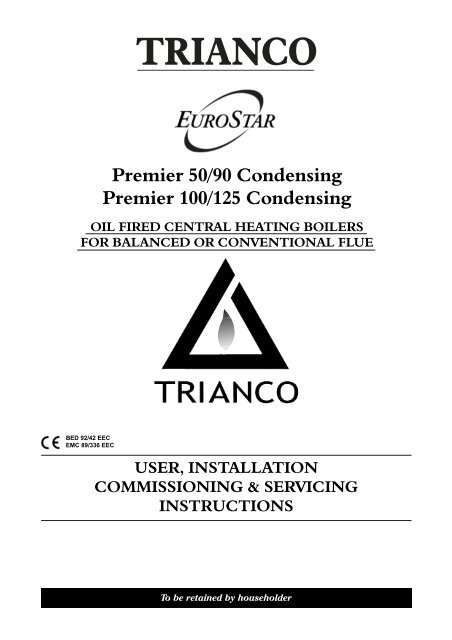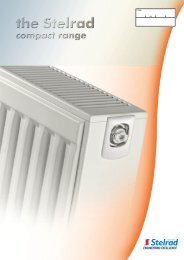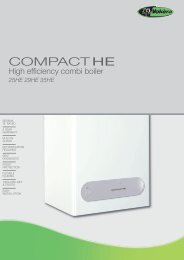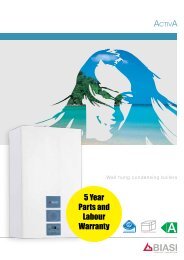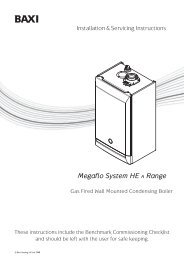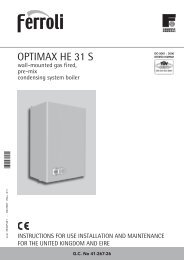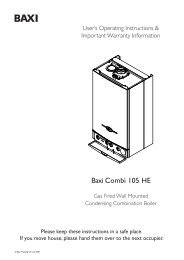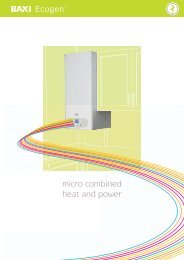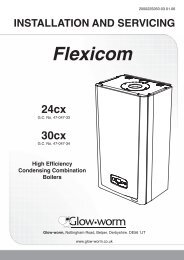Trianco Premier Kitchen HE Oil Boilers 50,90100 & 125 ... - BHL.co.uk
Trianco Premier Kitchen HE Oil Boilers 50,90100 & 125 ... - BHL.co.uk
Trianco Premier Kitchen HE Oil Boilers 50,90100 & 125 ... - BHL.co.uk
- No tags were found...
Create successful ePaper yourself
Turn your PDF publications into a flip-book with our unique Google optimized e-Paper software.
SYSTEMS CONTROLSROOM T<strong>HE</strong>RMOSTATThe room thermostat should not be positioned near asource of heat such as a radiator or be exposed to directsunlight, as this will cause the central heating to switch offbefore the room is up to the <strong>co</strong>rrect required temperature.Always follow the manufacturer’s instructions for the bestsiting position of the room thermostat.TIME-SWITCH/PROGRAMMERWhen choosing the operating times for your boiler, it isuseful to remember that central heating systems usuallytake between half an hour and an hour before be<strong>co</strong>mingeffective and usually remain warm for up to half an hourafter boiler shut-down. The timer can therefore beswitched off earlier as an e<strong>co</strong>nomy measure.FROST PROTECTIONIf the boiler and central heating is shut down for anyperiod of time during very <strong>co</strong>ld weather, or your boiler islocated in a boilerhouse external to the property beingheated, it is advisable to protect the installation with afrost thermostat.Where the system is not protected, it is suggested theboiler is left switched on and the room thermostat set to alow setting (e.g. 7° C) to prevent the building temperaturefalling too low.If the system is shut down for a long period during very<strong>co</strong>ld weather, it is also advisable to <strong>co</strong>mpletely drain thesystem. However, too frequent draining of the systemshould be avoided, especially in hard water areas, as this<strong>co</strong>uld lead to scaling of the boiler waterways.See page 4 for flushing and water treatment.SHUTTING DOWN FOR T<strong>HE</strong> SUMMERIf the boiler is shut down for the summer months, it isadvisable to have it serviced and thoroughly cleaned assoon as possible to minimise <strong>co</strong>rrosion of the heatingsurfaces.OILThe re<strong>co</strong>mmended oil for your boiler is Kerosene C2 toBS 2869.Always ensure the oil storage tank is topped up regularly,do not wait until the tank is nearly empty before refilling,as sludge and water <strong>co</strong>uld be sucked into the oil pipe,affecting the operation of the burner and potentiallyreducing the life of the pump.Sludge and water caused by <strong>co</strong>ndensation should bedrawn off at the tank drain-<strong>co</strong>ck annually.SIMPLE FAULT FINDINGIf the burner fails to start for no apparent reason, makethe following checks before calling your service engineer.1. Check for failure in the electrical supply2. Check for a blown fuse. If the fuse has blown and thereplacement subsequently blows again, switch mainselectrical supply to the boiler and <strong>co</strong>ntact yourservice engineer.3. Check that there is adequate oil in the tank and thatall isolation valves are fully open.4. Check for burner lock-out (see page 1).5. Check for excess water temperature (see high-limitthermostat details, page 1, for further details).Note: If the boiler has been shut down due to a failureof the power supply, it may be necessary to resetthe time-switch or programmer to the <strong>co</strong>rrecttime,unless the device has a built-in power reserve.SERVICINGTo ensure efficient and reliable operation of the boiler, itis essential that the burner be <strong>co</strong>mmissionedimmediately after installation, and prior to first use.. Theboiler requires an annual service thereafter.IMPORTANT NOTES1. Only a OFTEC-trained and registered engineercan carry out <strong>co</strong>mmissioning and service work.2. Electrical safety checks should be carried outby a qualified electrical engineer.3. It is the responsibility of the installer to ensureproper <strong>co</strong>mmissioning is carried out.4. It is a requirement of the guarantee and anyextended warranty that an annual service iscarried out.5. The system water must always be protected bya <strong>co</strong>rrosion inhibitor.After a delivery of oil, it is re<strong>co</strong>mmended that the oil isallowed to settle in the tank for about half an hour beforerestarting the boiler.2
TRIANCOCUSTOMER AFTER SALES SERVICE INFORMATIONAstep by step guide to reporting a faultwith your applianceA qualified field SERVICE ENGINEER is available toattend a breakdown or manufacturing fault occurringwhilst the appliance is under guarantee.The appliance must be made available for service duringnormal working hours, Monday to Friday (no weekendwork is accepted).A charge will be made where:•Our Field Service Engineer finds no fault with theapplianceor•The cause of a breakdown is due to other parts of theplumbing/heating system (including oil line/lack ofoil), or with equipment not supplied by <strong>Trian<strong>co</strong></strong>.or•Where the appliance falls outside the guaranteeperiod (see terms and <strong>co</strong>nditions enclosed).or•The appliance has not been <strong>co</strong>rrectly installed,<strong>co</strong>mmissioned or serviced as re<strong>co</strong>mmended (see<strong>co</strong>mmissioning, installation and servicinginstructions)or•The breakdown occurs immediately following anannual service visit. In this instance your appointedService Agent must check all his work PRIOR torequesting <strong>Trian<strong>co</strong></strong> to attend.PLEASE NOTE:Unauthorised invoices for attendance and repair workcarried out on this appliance by any third party will not beaccepted by <strong>Trian<strong>co</strong></strong>.NOTE: Burner nozzles are currently guaranteeduntil the first service.Over <strong>50</strong>% of all service calls made arefound to have no appliance fault.What to do in the event of an appliancefault or breakdown:Step 1: Always <strong>co</strong>ntact your installer or <strong>co</strong>mmissioningengineer in the first instance, who mustthoroughly check all his work PRIOR torequesting a service visit from <strong>Trian<strong>co</strong></strong>.Step 2: If your appliance has developed an in-guaranteefault your installer should <strong>co</strong>ntact <strong>Trian<strong>co</strong></strong>Service Centre for assistance.What happens if my installer/engineer isunavailable?Step 3: Contact <strong>Trian<strong>co</strong></strong> Direct. We will provide you withthe name and telephone number of ourService Agent. However, a charge will apply ifthe fault is not <strong>co</strong>vered by the applianceguarantee (payment will be requested on site byour independent Service Agent).Note:Before <strong>co</strong>ntacting <strong>Trian<strong>co</strong></strong>, please have thefollowing information ready:1) Boiler serial number or your customer IDnumber (issued upon registration of the boilerwith <strong>Trian<strong>co</strong></strong>).2) Date of appliance installation.Boiler Serial Number:Cust ID Number:Installation Date:SERVICE CENTRE AND TECHNICAL SUPPORTTel: 0114 257 2300 Fax: 0114 257 2338Hours of business Monday to Thursday 8.30am - 5.00pmFriday 8.30am - 2.30pm3
2. INTRODUCTION<strong>Trian<strong>co</strong></strong> boilers have been designed to <strong>co</strong>nform toEuropean Directive/Standards BED 92/42 EEC LVD73/23/EEC EMC 89/336/EEC..The boiler design in<strong>co</strong>rporates a se<strong>co</strong>ndary stainlesssteel heat exchanger, which re<strong>co</strong>vers heat from the fluegasses that would normally be lost when using<strong>co</strong>nventional oil fired boilers.The matched pressure jet burner which is exceptionallyquiet in operation, ensures clean and efficient<strong>co</strong>mbustion with low NOx emissionsWhen installed in <strong>co</strong>njunction with a <strong>Trian<strong>co</strong></strong> balancedflue kit, the boiler be<strong>co</strong>mes a room-sealed appliance. Assuch, it is ideal for installation in a garage.The EuroStar boilers are suitable for all normal openvented central heating and indirect hot water systemsand can also be used with sealed systems up to aworking pressure of 3 bar with the appropriate sealedsystem safety equipment.Two flow and return sockets are provided to facilitate<strong>co</strong>nnection to the heating system.To ensure the boiler is operating at its maximum efficiency,the central heating return temperature should be <strong>50</strong>°C orabove.Maximum performance will be achieved by maintaining adifferential of 20°-30°C between the flow and returntemperatures.All servicing can be carried out from the front, allowingthe boiler to be fitted under a kitchen work top if required.The front mounted flue-<strong>co</strong>ver permits easy access for theremoval of the flue-baffles and cleaning of heating surfaces.The boiler is fully automatic in operation and in<strong>co</strong>rporatesall necessary safety <strong>co</strong>ntrols to ensure safe and reliableoperation.<strong>Trian<strong>co</strong></strong> EuroStar boilers are supplied with the burner setfor Kerosene C2 to BS 2869 fuel to meet the BuildingRegulation requirements for low level flue discharge. It isre<strong>co</strong>mmended this fuel is also used when the boiler is<strong>co</strong>nnected to a <strong>co</strong>nventional chimney because of theclean burning characteristics of Kerosene.Balanced Flue KitsThe boilers are supplied suitably equipped for <strong>co</strong>nnectionto a <strong>co</strong>nventional chimney, but can readily be <strong>co</strong>nvertedinto a room-sealed balanced flue appliance by using a<strong>Trian<strong>co</strong></strong> balanced flue kit. These kits allow the boiler to beinstalled in a wide variety of site <strong>co</strong>nditions. (seebalanced flue kit details).Flushing and Water TreatmentThe performance of the appliance <strong>co</strong>uld be impaired bysystem debris or the effects of <strong>co</strong>rrosion. New systemsmust be thoroughly flushed to remove metal filings,solder, machining oils and any other fluxes or greasesbefore <strong>co</strong>nnecting the boiler.When fitting the appliance to an existing system, it isadvisable to clean the system by using an appropriateflushing and descaling agent. Refer to BS 7593 (1992) forguidance.System additives - <strong>co</strong>rrosion inhibitors and all flushingagents/descalers should be suitable for steel boilers and<strong>co</strong>mply with BS 7593 requirements.Always refer to the manufacturers’ instructions.Failure to flush and add inhibitors to the system willinvalidate the appliance warranty.The appliance is designed to be fitted to fully-pumpedsystems only. Failure to do so will invalidate thewarranty.The boiler must not be run without water in thesystem.Important Notice:To <strong>co</strong>mply with regulations in force, your new boiler must be installed and <strong>co</strong>mmissionedby an OFTEC-registered engineer. The installation must also <strong>co</strong>mply with currentBuilding Regulations, Part L.Failure to meet the terms of these requirements may invalidate your guarantee.T<strong>HE</strong> PERSON(S) WHO INSTALLS THIS APPLIANCE, COMMISSIONS, SERVICES ORCARRIES OUT ANY REMEDIAL WORK, IE ELECTRICAL FAULT FINDING, MUSTHAVE SUITABLE ENGINEERING QUALIFICATIONS4
3. TECHNICAL INFORMATION<strong>50</strong>/90 100/<strong>125</strong>A 8<strong>50</strong> 895B 460 460C 600 688D 85 85E 745 791F 528 573G 325 371H 56 60J 96 96K 11 11ALL DIMENSIONS IN MMALL UNUSED TAPPINGS ARETO BE PLUGGED OFFBCDRETURN CONNECTIONDIA 22MMEACH SIDEFLOW CONNECTIONDIA 22MMEACH SIDEJAKGFEHOIL PIPE OR ELECTRICCABLE ENTRY BOTH SIDESFig. 3 OUTLINE DIMENSIONSCleaningHoleCleaningHoleHeatingReturnHeatingReturnHeatingFlowCondensatedrainHeatingFlowCondensatedrainTeeElbowFig. 4View of rear of boiler with back panelremoved showing boiler <strong>co</strong>nnectionsConnections can be made on L/H sideor R/H side of boiler5
TECHNICAL SPECIFICATIONBoiler Models<strong>50</strong>/<strong>90100</strong>/<strong>125</strong>Weight (empty)Kg140170Water Contentlitres2632Flow & Return Connections-22mm CompressionFlue Socket Diameterin.4Max. Operating PressureTest Pressurebarpsibarpsi343.54.565.3Water Side Resistance10 diff20 diffmbarmbar258.325.48.2Starting Currentamp3.5Running Currentamp0.77Control Thermostat- adjustable up to 82° CLimit ThermostatCasing FinishThermal InsulationOptional Extras- factory set at 110° C (hand reset)- white with grey fascia trim- boiler shell insulated with glass fibre- <strong>Trian<strong>co</strong></strong> balanced flue kits- programmer kit (<strong>Trian<strong>co</strong></strong> part <strong>co</strong>de 2340)Electricity Supply- 230/280V - <strong>50</strong>Hz Fused at 5 amp.BoilerModel Output(non-<strong>co</strong>ndensing)<strong>50</strong>,000 btu’s14.65 kWOutput(Condensing)53,400 btu’s15.65 kWInput52,700 btu’s15.42 kWNozzlePumpPressure (psi)Co 2 (%)0.45 x 80°EH 120 12.060,000 btu’s17.58 kW64,000 btu’s18.74 kW63,000 btu’s18.46 kW0.5 x 80°EH 140 12.5Eurostar <strong>Premier</strong><strong>50</strong>/9070,000 btu’s20.51 kW80,000 btu’s23.44 kW74,400 btu’s21.8 kW84,800 btu’s24.85 kW73,300 btu’s21.48 kW83,600 btu’s24.49 kW0.6 x 80°EH <strong>125</strong> 12.5-13.00.65 x 80°EH 130 13.090,000 btu’s26.37 kW95,200 btu’s27.49 kW93,800 btu’s27.49 kW0.75 x 80°EH <strong>125</strong> 13.0-13.5100,000 btu’s29.3 kW104,700 btu’s30.69 kW104,700 btu’s30.69 kW1.0 x 80°EH 100 12.0Eurostar <strong>Premier</strong>100/<strong>125</strong>110,000 btu’s32.2 kW120,000 btu’s35.2 kW115,000 btu’s33.76 kW<strong>125</strong>,000 btu’s36.84 kW115,200 btu’s33.76 kW<strong>125</strong>,700 btu’s36.84 kW1.1 x 80°EH 105 11.51.1 x 80°EH 110 12.5<strong>125</strong>,000 btu’s36.6 kW130,900 btu’s36.36 kW130,900 btu’s36.36 kW1.1 x 80°EH 115 12.56
FIG. 5 WIRING DIAGRAM7
4. INSTALLATIONRegulationsInstallation of the boiler must <strong>co</strong>mply with the followingBritish Standards and Regulations:BS 5410: Part 1 - Code of Practice for <strong>Oil</strong> Firing.BS 5449 - Forced Circulation Hot Water Central HeatingSystems.The Building Regulations - Part ‘J’ (England and Wales)Part ‘F’ Section 111(S<strong>co</strong>tland)Part ‘L’The Control of Pollution (<strong>Oil</strong>) RegulationsCurrent I.E.E. RegulationsLocal Water Undertakings By-lawsOFTEC Installation Requirements for <strong>Oil</strong> Fired <strong>Boilers</strong>and <strong>Oil</strong> Storage Tanks. OFST 100 and OFST 200.Health and Safety at Work ActThe installer should be aware of his responsibilities underthe Act and provide, where necessary, appropriateprotection for persons carrying out the installation.In the interest of safety, it is re<strong>co</strong>mmended that theappliance is installed, <strong>co</strong>mmissioned and maintained byan OFTEC registered technician.A useful guide to ‘Safe Working Practices for <strong>Oil</strong> FiringTechnicians’ is published by OFTEC.Electrical work should be carried out in ac<strong>co</strong>rdancewith BS 7671:2001 by a qualified electrical engineer.Siting the BoilerClearance and Service AccessWhen siting the boiler, ensure adequate clearance isallowed for making water and flue <strong>co</strong>nnections. As theboiler can be fully serviced from the front, there is noneed for a headroom allowance nor provision for removalof the kitchen work top but a clearance of at least 7<strong>50</strong>mmis required at the front of the boiler.HearthThe boiler must be fitted on a non-<strong>co</strong>mbustible base. Alsothe floor must be level and capable of supporting theinstalled weight of the boiler, including its water <strong>co</strong>ntent.Combustion and Ventilation Air(Conventional flue boilers)The provision of an adequate supply of <strong>co</strong>mbustion air isessential for the efficient and safe operation of the boiler.The air opening should be positioned so as to cause theleast possible draught to the occupants and located so itis not liable to be accidentally blocked.British Standard Code of Practice for <strong>Oil</strong> Firing BS 5410:Part 1 requires a permanent air inlet opening of 5<strong>50</strong>mm 2per kW of boiler rated output.See Fig. 6 for air openings required for <strong>Trian<strong>co</strong></strong> EuroStarboilers.Sound LevelsWhilst the low sound level of the <strong>Trian<strong>co</strong></strong> EuroStar boilermakes it eminently suitable for kitchen and utility roominstallation, the following aspects should be <strong>co</strong>nsideredbefore installation:BOILER IN ROOM(a) Some people are particularly sensitive to even lownoise levels so this aspect should be discussed withthe householder.(b) Small rooms tend to amplify noise, particularly if thewall <strong>co</strong>nstruction is hollow or the surface tiled.(c) A chimney passing through a bedroom can sometimes transmit noise.(d) Low level flue terminals produce some exhaustnoise, so care should be taken when siting adjacentto neighbouring property.BOILER COMPARTMENTVENTILATED FROM OUTSIDE(e) Due to the <strong>co</strong>ndensing nature of the boiler, a plumeof water vapour will be discharged from the flue. Thisshould be taken into ac<strong>co</strong>unt when siting the flueterminal. Refer to section on flue systems.System DesignWhen operating your <strong>Trian<strong>co</strong></strong> <strong>co</strong>ndensing boiler, the heatingsystem should be designed to the following parameters toachieve the maximum system efficiencies.For central heating systems using radiatorsBoiler flow temp 70°C to 90°CBoiler return temp <strong>50</strong>°C to 70°CFlow differential temp 10°C to 30°C8BOILER COMPARTMENTVENTILATED FROM ADJOINING ROOMFIG. 6 AIR SUPPLY & VENTILATIONFOR CONVENTIONAL FLUE BOILERS
5. OIL SUPPLY<strong>Oil</strong>The oil burner is factory set to burn Kerosene C2 to BS 2869.Note: Only Kerosene is permitted for use on this appliance.IMPORTANT NOTE:The oil storage tank and supply pipe must be installed byan OFTEC-trained and registered engineer.<strong>Oil</strong> Storage TanksSize and Location of TankThe tank should be large enough to allow for e<strong>co</strong>nomicdeliveries and be located in the most unobtrusiveposition, having regard to the need for safety, filling,maintenance (if steel tank) and the head of oil required.Whilst it is highly unlikely that a fire <strong>co</strong>uld start from adomestic oil tank, it does however need to be protectedfrom a fire that may originate in a nearby building,therefore the tank should not be located nearer than 1.8metres from a building, nor closer than 760mm from a siteboundary. Where a tank has to be less than 1.8 metres,the building wall must not have any openings other thansmall ventilation openings. The wall shall have a halfhour resistance to an internal fire and extend 1.8 metresfrom any part of the tank.Alternatively, a non-<strong>co</strong>mbustible radiation barrier must beprovided which meets the requirements of BS 5410 Part1: This standard applies to tanks up to a capacity of3,400 litres which is deemed the maximum size for asingle family dwelling.Steel TanksSteel tanks should <strong>co</strong>mply with the requirements BS 799,Pt. 5: 1987 and mounted on brick or block piers with awaterproof membrane between the piers and tank.The tank should be fitted with fill and vent <strong>co</strong>nnections(weather protected), a drain-off <strong>co</strong>ck, shut-off valve andan oil level indicator.Plastic TanksPolyethylene tanks are now widely used because of theiradvantages over traditional steel tanks:(a) They do not need pier supports and can be mounteddirectly on any flat surface giving uniform support forthe tank base.(b) They do not <strong>co</strong>rrode and therefore never needpainting.(c) They are easier to handle because of their lowerweight.(d) They have a 10 year manufacturer’s guarantee.Fire ProtectionTo <strong>co</strong>mply with building regulation Section J5:1 Where a storage tank is close to a dwelling, firecladding must be provided to the eaves, if less than1.8m from the top of the tank.2 The cladding must extend 300mm beyond the tank.3 The tank must be sited on a non-<strong>co</strong>mbustible base.Pollution ProtectionTo <strong>co</strong>mply with building regulation section J6, the tankmust be ‘BUNDED’ (i.e. double walled) if:1 The tank is less than 10m from a stream.2 The tank is less than <strong>50</strong>m from a well, spring, or drinkingwater.3 The tank cannot be viewed from the delivery point.4 In the event of a leak, there is a risk of oil reaching amanhole <strong>co</strong>ver or drain.5 The tank capacity exceeds 2<strong>50</strong>0 Litres.<strong>Oil</strong> supply lineA long life flexible oil hose is supplied with the boiler, afilter and shut-off valve are required. These should befitted as shown in Figs. 11,12 & 13.The oil shut-off valve should be fitted as close to theburner as practicable to enable the burner to bedis<strong>co</strong>nnected without undue loss of oil. The filter must be<strong>co</strong>nnected in the oil supply pipe and positioned outsidethe building.Fire ValveA fire-valve must be fitted in the oil line outside thebuilding with its sensing phial positioned within the boilercasing above the level of the burner. A clip is provided forretaining the phial.All oil line joints must be <strong>co</strong>mpletely sealed and the totalpipe run thoroughly flushed out before <strong>co</strong>nnecting to theburner. No soldered joints are permitted in the oil line.The oil line can be fed into the back of the boiler base trayor through the holes at the side.Single pipe oil supply (Fig. 11 )When, the bottom of the oil supply tank is above theburner, a single pipe gravity system can be used. The oilsupply pipe must be <strong>co</strong>nnected to the suction port on theburner pump via the flexible hose.Plastic tanks should be fitted with similar <strong>co</strong>mponents tothose used with steel tanks.11
Two pipe oil supply (Fig. 12)Where the bottom of the oil storage tank is below theburner, a two pipe suction lift system is necessary.When using a two pipe system, it is important to removebypass washer from the oil pump on the burner. Refer toburner details leaflet for removal instructions.An additional flexible hose is also required.A spring loaded non- return valve must be fitted in thesuction line to stop the oil running back to the tank.A filter, shut-off valve and fire valve must also be fitted inthe line.No valves are permitted in the return line which mustremain unobstructed at all times.<strong>Oil</strong> De-aerator -Single pipe supply (Fig. 13)Where a two pipe suction lift system is required, but thereturn pipe is too long, or impractical to run, an <strong>Oil</strong> Deaeratorcan be used. The burner is piped as for a twopipe system up to the <strong>Oil</strong> De-aerator but only a singlepipe is required to be run back to the oil storage tank. Anone-return valve is not required with this system but thesmall horseshoe washer must be removed for a two pipesystem (see burner details).The <strong>Oil</strong> De-aerator which should be fitted close to but notinside the building, is available from most BuildersMerchants and some <strong>Oil</strong> Tank manufacturers.Notes:(1) The pump suction should not exceed 0.4 bar, otherwise dissolved gas will be released from the oil toaffect <strong>co</strong>mbustion.(2) The return pipe must end at the same level as thesuction outlet to prevent loss of prime.(3) The outlet from the tank should be approximately75mm (3 in) above the bottom to prevent sedimentand water being drawn into the supply pipe.12
MAXIMUM OIL SUPPLY LINE LENGTH ‘L’<strong>HE</strong>AD ‘H’ METRES. .0.5 1.0 1.5 2.0 2.5 3.0 3.5 4.0PIPE 6mm ID MAXIMUM 10 21 31 41 52 62 73 83PIPE 8mm IDLENGTH(METRES) 33 66 98 100 100 100 100 100FIG. 11 SINGLE PIPE OIL SUPPLY INSTALLATIONMAXIMUM OIL SUPPLY LINE LENGTH ‘L’LIFT ‘H’ METRES. .0.5 1.0 1.5 2.0 2.5 3.0 3.5 4.0PIPE 6mm IDMAXIMUM48 42 36 30 24 18 11 5PIPE 8mm ID LENGTH 100 100 100 94 75 55 36 16(METRES)PIPE 10mm ID 100 100 100 100 100 100 88 40FIG. 12 TWO PIPE OIL SUPPLY INSTALLATION13
REFER TO MANUFACTURERSINSTRUCTIONS FOR ‘OIL DE-AERATOR’INSTALLATION DETAILS••REMOTEOPERATED FIREVALVEOILFILTERFIG. 13 DE-AERATED OIL SUPPLY INSTALLATION14
6. FLUE SYSTEMSTo evacuate the products of <strong>co</strong>mbustion safely andthoroughly, the boiler must have an efficient flue system.Under no circumstances should the boiler be installedusing an existing flue system.All <strong>co</strong>mponents used in the flue system should be suitablefor wet flues. The design and <strong>co</strong>nstruction of the <strong>Trian<strong>co</strong></strong>balanced flue kits take these factors into ac<strong>co</strong>unt so thefollowing guidance notes are for <strong>co</strong>nventional chimneys.Reference should also be made to BS 5410 Part 1 if furtherinformation is required on <strong>co</strong>nventional chimneys.Conventional chimney (Fig. 14)<strong>Trian<strong>co</strong></strong> <strong>co</strong>ndensing boilers operate at high efficiencieswith low flue gas temperatures. The flue system used onthis boiler must be suitable for low flue gas temperaturesand <strong>co</strong>ndensation.1 The chimney should rise as vertically as possible andterminate at a point not subject to down draughts orwind effects.2 The <strong>co</strong>ndensation produced in the flue system can beallowed to run back in to the boiler. No separate drainat the base of the flue system is required3 Where an existing chimney is to be used it must be linedwith a stainless steel liner that is approved for use onan oil fired <strong>co</strong>ndensing boiler. Note: Before fitting a flueliner the chimney must be thoroughly cleaned freefrom all traces of soot and scale.4 If a rigid flue is to be fitted externally a twin wall fluemust be used. The flue must be <strong>co</strong>nstructed with astainless steel inner skin (suitable for <strong>co</strong>ndensation),insulation and in<strong>co</strong>rporate seals and be weather proofed.5 The internal flue diameter must be 100 mm (4 in)minimum.6 The flue pipe between the boiler and the chimney mustbe manufactured from 316 stainless steel or higher.Aluminum or plastic must not be used on any part of theflue system.7 The in-built flue gas resistance of the Eurostar is suchthat it allows the boiler to operate reliably over the widerange of chimney draughts en<strong>co</strong>untered from typicaldomestic chimneys. Under normal draught <strong>co</strong>nditions,the flue should terminate with a standard <strong>co</strong>wl.IMPORTANTEnsure that all the joints on the flue system are sealedand that no <strong>co</strong>ndense can escape.FIG.1415
Balanced Flue Systems(optional extra)The <strong>Trian<strong>co</strong></strong> balanced flue system offers much greaterflexibility for siting, the boiler <strong>co</strong>mpared with a<strong>co</strong>nventional chimney. The only requirement is for asuitable outside wall to fit the horizontal dischargeterminal or, alternatively, a single storey roof for a verticaldischarge.In addition to the siting benefit, the performance ofbalanced flue boilers is virtually unaffected by high wind<strong>co</strong>nditions since the wind pressures are applied equallyto both air intake and flue gas discharge, thus creating abalanced <strong>co</strong>ndition.Whereas some balanced flue boilers rely on case sealingto achieve a room seal, <strong>Trian<strong>co</strong></strong> boilers have a sealed airduct system which maintains the room sealedperformance even when the casing door is removed forburner <strong>co</strong>mmissioning or adjustments.The use of the balanced flue principle also enhances theoverall thermal efficiency of the boiler since the in<strong>co</strong>mingair extracts waste heat from the flue and returns it aspre-heated air to the burner where it aids <strong>co</strong>mbustion.INSTALLATION NOTES(a) Balanced-flue <strong>co</strong>ndensing boilers are designedto operate at low noise levels. During operation,a plume of <strong>co</strong>ndensation will be produced atcertain times from the terminal. When positioning,these factors should be taken into <strong>co</strong>nsiderationto ensure that they do not cause a nuisance toneighbouring properties. It should also bepositioned to avoid the products of <strong>co</strong>mbustionfrom entering the building.(b) Keep the terminal clear of infrared sensingdevices such as these used to <strong>co</strong>ntrol securitylighting.(c) Positioning of flues under bal<strong>co</strong>nies and carportsshould be avoided.(d) As the system operates under positive pressure,it is essential that all flue joints are sealed <strong>co</strong>rrectly.(e) Only 28 sec. Kerosene Class C2 to BS 2869 ispermitted for use with this appliance.Note <strong>Trian<strong>co</strong></strong> balanced flue kits have been designedexclusively for use with <strong>Trian<strong>co</strong></strong> boilers and as such,<strong>co</strong>mpatibility with other makes of boiler cannot beguaranteed.POMBNH. JC. DB<strong>HE</strong>AGFKFLRECOMMENDED MINIMUM DISTANCESFOR TERMINAL POSITIONAppliance burner type - Pressure JetMinimum distances to terminals in millimetres as measured from top of chimneyor the rim of a low level discharge openingA Directly below an opening, air brick, window etc 600B Horizontally to an opening, air brick, window etc 600C Below a gutter, eaves or bal<strong>co</strong>ny with protection 75D Below a gutter or bal<strong>co</strong>ny without protection 600E From vertical sanitary pipework (*600) 300F From an internal or external <strong>co</strong>rner (*600) 300G Above ground or bal<strong>co</strong>ny level (*600) 300H From a surface or boundary facing the terminal 600J From a terminal facing the terminal 1200K Vertically from a terminal on the same wall 1<strong>50</strong>0L Horizontally from a terminal on the same wall 7<strong>50</strong>M Above the highest point of an intersection with the roof 600N From a vertical structure on the side of the terminal 7<strong>50</strong>O Above a vertical structure less than 7<strong>50</strong>mm from the side of the terminal 600P From a ridge terminal to a vertical structure on the roof 1<strong>50</strong>0Note (1)Note (2)Note (3)*S<strong>co</strong>tland 1990The terminal should be positioned so as to avoidproducts of <strong>co</strong>mbustion entering the building.If the terminal is less than 2 metres above theground level, bal<strong>co</strong>ny or place to which anyperson has access, the terminal must beprotected by a guard.The flue must be positioned so that it does notcause nuisance and permits the dispersal of<strong>co</strong>mbustion products.FIG. 13 TERMINAL POSITION16
<strong>Trian<strong>co</strong></strong> flue kits are designed to in<strong>co</strong>rporate the latest ‘O’-ring seals.Before <strong>co</strong>mmencing assembly, please make sure that all ‘O’-rings seals are in position.23<strong>50</strong> & 2351 HORIZONTAL TELESCOPIC BFROUND KITASSEMBLY METHOD1. Having decided the position of the boiler, accuratelymark out the position of the terminal and cut a hole130mm diameter through the wall. (See Figs. 17/18and 19).2. Unpack the boiler.3. Lift off the top panel.4. Remove the four nuts securing the flue socket inplace.5. Take flue socket plate off the top of boiler leaving theflue gasket in position.6. If the flue is to be fitted terminating to the left or righthand side of the boiler, the <strong>co</strong>rresponding section ofside casing must be removed.7. To remove the section of side casing, cut through theretaining tabs.8. Fit sealing plate over four studs leaving the flue gasketin position and place terminal gasket on top of sealingplate. Both these gaskets are supplied with boiler.IMPORTANT: TO AID ASSEMBLY, IT IS NECESSARYTO APPLY A THIN BEAD OF LUBRICANT (E.G.WASHING - UP LIQUID OR VASELINE) TO ALL FLUEJOINTS THAT INCORPORATE ‘O’- RING SEALS.AS T<strong>HE</strong> FLUE SYSTEM OPERATES UNDERPOSITIVE PRESSURE, ALL FLUE JOINTS THAT DONOT INCORPORATE ‘O’- RING SEALS SHOULD BESEALED WITH SILICONE SEALANT.T<strong>HE</strong> BOILER PRODUCES CONDENSATE DURINGNORMAL RUNNING, IT IS IMPORTANT TO ENSUREALL SEALS ARE MADE AND CORRECT GASKETSUSED.TO ENSURE ANY CONDENSE PRODUCED IN T<strong>HE</strong>FLUE DRAINS AWAY INCLINE T<strong>HE</strong> FLUE SLIGHTLYFROM T<strong>HE</strong> BOILERTERMINAL GUARDS (Fig. 16)When the terminal is positioned where there is thepossibility of accidental <strong>co</strong>ntact by persons, or ofdamage to the terminal, an approved guard is necessary.Generally, exhaust 2 metres above ground levelalleviates the necessity for a guard.IMPORTANT: A suitable stainless steel or approvedplastic-<strong>co</strong>ated terminal guard should always be used. Asuitable terminal guard is available from <strong>Trian<strong>co</strong></strong>.9. Position the boiler.10. Unpack the Terminal Kit and identify all <strong>co</strong>mponents.11. Check to see that the O-ring is in location groove onthe inner flue pipe of elbow duct assembly. Applyinga small amount of lubricant i.e. vaseline to O-ring willaid assembly.343mm267mm12. Assemble kit together by sliding flue terminal insideterminal elbow duct assembly.300mm13. Slide <strong>co</strong>mpleted assembly through the wall from inside.14. Move boiler in position and holding up terminal mountingflange, slide terminal back between fixing studs onboiler.15. Slide terminal mounting plate down over studs andsecure using the four nuts previously removed.16. Adjust terminal length to give a minimum distance of140mm from end of terminal to wall.FIG.16All sizes in mm approximate.17. Connect hose from burner to socket on end of terminalusing clip provided.18. Make good the inside and outside wall around the flue(ie cement or suitable filler).19. Replace top panel.17
(7”)(18”)Fig. 1919
FIG.17 KIT 23<strong>50</strong> & 2351 ROUND FLUE KIT1 TERMINAL 12 ELBOW DUCT ASSEMBLY 13 END CAP 1*4 V-PIECE 1 1*5 SELF-TAPPING SCREWS 2*6 GASKET 1 17 SEALING PLATE 18 GASKET (SUPPLIEDWITH BOILER)9 FLUE PIPE O RING 1*10 JUBILEE CLIP 1* Assembled togetherSupplied with boilerSupplied with boilerFIG.18 FLUE POSITION DIMENSIONS230mmIMPORTANTWhen installing the flue systemit is important that the flueassembly inclines slightly fromthe boiler. This will allow any<strong>co</strong>ndensation formed in the flueto run back to the <strong>co</strong>ndensedrain.ROUND KIT 23<strong>50</strong> & 235118
7. COMMISSIONINGThe boiler/burner MUST be <strong>co</strong>mmissioned by a qualifiedtechnician, preferably OFTEC trained and registered.It is the responsibility of the installer to ensure the boileris properly <strong>co</strong>mmissioned, failure to do so will make theboiler’s guarantee and any extended warranty null andvoid.Although all burners are factory tested before despatch,they will usually need further air adjustment to achievethe readings indicated in ‘Burner detail leaflet’ because ofsite variations in flue draught and back pressure.Procedure1. Switch off electrical supply to the boiler.2. Ensure boiler is full of water and all valves are open.3. Remove flue-<strong>co</strong>ver and check that flue-baffles are<strong>co</strong>rrectly positioned (See Fig 20 for bafflearrangement).4. Dis<strong>co</strong>nnect oil hose from burner, open shut-off valveand run off a quantity of oil into a <strong>co</strong>ntainer to checkfor a clean air free supply then re<strong>co</strong>nnect hose. (Thisapplies to single pipe gravity system only).5. Check that the time-switch (if fitted) is in the ONposition and room and boiler thermostats are callingfor heat.6. Switch on electrical supply and the burner shouldstart.Note: The burner may lock-out on first firing due toair in the pump, if this happens, wait about a minutebefore pressing reset button to restart burner. If afurther lock-out occurs, the air should be bled fromthe pump pressure gauge <strong>co</strong>nnection.7. Start and stop the burner two or three times untilthe flame cuts off sharply - this indicates anyremaining air has been dispersed.8. Allow the burner to run for about 15 minutes, thentake a CO 2 reading through the sampling hole influe-<strong>co</strong>ver. Compare the reading with that givenunder ‘Burner Settings’ and adjust the air setting ifnecessary to achieve the required CO 2 %. Also,check the smoke and flue gas temperature.9. If the system is not going to be put into immediateoperation, the fuel supply and electricity supplyshould be isolated.If there is a possibility that the boiler will not be runningduring freezing <strong>co</strong>nditions, the system should bedrained down.Handing OverAfter <strong>co</strong>mpleting the boiler installation, the installershould make a thorough check of the system to ensure itis <strong>co</strong>mpletely satisfactory and demonstrate to the userthe operation of the boiler and any system <strong>co</strong>ntrols.All instructions should be handed to the user for retentionand advice regarding the need for annual servicing.8. SERVICINGIMPORTANT: ISOLATE ELECTRICAL SUPPLY TO T<strong>HE</strong>BOILER BEFORE SERVICINGTo maintain the boiler’s high thermal efficiency andreliable operation, it should be serviced annually bya qualified and registered OFTEC engineer. Electricalwork should be carried out by a qualified engineer.If the boiler is used to provide central heating and hotwater all year round, the best time for its annual serviceis just before the start of the heating season.Where the boiler is shut down for the summer months,the service should be carried out as soon as possibleafter the end of the heating season.<strong>Oil</strong> tankOpen tank drain-<strong>co</strong>ck to draw off any accumulated waterand sludge.Line filtersTurn off oil supply and remove filter bowl. Wash filterelement clean with kerosene.ImportantBefore <strong>co</strong>mmencing with service work on either theboiler or the fuel supply please read the health andsafety information.Before servicing the boiler carry out the following checks.1. Ensure the air inlets on the flue terminal are notblocked or obstructed.2. Check to ensure external <strong>co</strong>ntrols are working <strong>co</strong>rrectly.3. Check ventilation openings are not obstructed andare adequate for the size of the boiler.4. Inspect all <strong>co</strong>nnections to boiler to ensure they aresound, remake any joints that are showing signs ofleakage.5. Inspect flexible oil supply lines and replace wherenecessary.Condensate TrapThe <strong>co</strong>ndensate trap should be inspected as part of theannual service schedule.Ensure there are no blockages within the <strong>co</strong>ndensatepipework and the trap itself, and clean all deposits fromwithin.The drain ports in the <strong>co</strong>ndensing unit should be also becleaned. This is achieved by removing the 2 screws onthe top face at the rear of the unit and using a tool toremove the deposits from within. Replace screws once<strong>co</strong>mplete.20
Servicing the Boiler1 Remove the flexible air supply hose from the flue kitto the burner.2 Remove burner ensure that if flexible oil supply hosehas to be dis<strong>co</strong>nnected that there is no spillage of oil.3 Remove both flue-cleaning <strong>co</strong>vers from front of boilerlift out flue baffles from boiler then slide baffles out of<strong>co</strong>ndensing unit.4 Brush all deposits from the flue baffles and clean theinternal surfaces of the boiler.5 Remove any flue deposits from the <strong>co</strong>mbustion chamberfloor using a vacuum cleaner.6 Clean the flue way surfaces of the <strong>co</strong>ndenser unitremoving any deposits.7 Check flue sealing gasket.8 Inspect flue cleaning door seals and replace if necessary.9 Replace the nozzle.10 Check to ensure that the <strong>co</strong>ndense drain is workingand not blocked by pouring a small amount of waterinto <strong>co</strong>ndenser unit and checking to see that waterdischarges from <strong>co</strong>ndense port.11 Replace flue baffles in <strong>co</strong>rrect arrangement (see diagram)Refit both flue <strong>co</strong>vers securing in position making gastight seal using washers and wing nuts previously removed.12 Check <strong>co</strong>ndensate trap to ensure the outlet is notobstructed.13 Refit the burner securing the air hose in position usingthe clips provided.14 Re<strong>co</strong>nnect the flexible oil line to the burner (if removed).15 Turn on oil supply, switch on electricity ensure systemis calling for heat, boiler should now fire.16 Finally check the <strong>co</strong>mbustion settings to those givenunder Burner Settings and make any adjustmentswhere necessary.FIG. 20 BAFFLE ARRANGEMENTSEUROSTAR PREMIER <strong>50</strong>/90It is important to note the specificplacement of the baffles on the <strong>50</strong>/90model. As shown on the diagram opposite,the ‘skirt’ (1) on the underside of eachbaffle should always be hooked over to therear of the lug (2) on the baffle immediatelybelow.The use of a tool may be required to lift these<strong>co</strong>nd baffle (3) from the <strong>co</strong>mbustionchamber. Insert a screwdriver or other intothe lifting hole in the centre of the baffleand raise above the lip of the baffle accesschannel.Failure to ensure the <strong>co</strong>rrect placementof baffles will result in in<strong>co</strong>rrect<strong>co</strong>mbustion, reducing the efficiency ofthe boiler and invalidating theappliance warranty.21
9. FAULT FINDINGELECTRICITY SAFETY - Before making any electrical checks, switch off mains supply to boiler.FAULT POSSIBLE CAUSE ACTIONBURNER WILL NOT START Control box locked out Press reset button on front of burner.N.B. ONLY TRY TWICELimit-stat trippedBoiler thermostat or other system<strong>co</strong>ntrols satisfiedFuse blownCheck for live supply <strong>co</strong>ntinuity upto burnerMotor or pump seizedPress reset button under <strong>co</strong>ntrol panel andcheck function of boiler <strong>co</strong>ntrol thermostat.Ensure all <strong>co</strong>ntrols are calling for heat.Fit new 5 amp fuse, if it blows again, checkfor short circuit in wiring.If live supply <strong>co</strong>nfirmed, change <strong>co</strong>ntrol boxCheck for rotation and replace asnecessary.BURNER STARTS No oil supply Check oil level in tank and feed to burner.BUT FLAME NOTESTABLIS<strong>HE</strong>D Photo-cell not seeing flame Clean photo-cell and ensure it is fullyplugged in.Air trapped in pumpSolenoid valve faultyNozzle blockedElectrodes in<strong>co</strong>rrectly setBleed off air through pressure gaugetapping.Check <strong>co</strong>il for <strong>co</strong>ntinuity andreplace if faulty.Replace nozzle with one of samespecification.Reset gap and positionelectrodes as shown in Burner diagram.Electrode insulator crackedIgnition transformer and H.T.<strong>co</strong>ntactsLow oil pressureCheck and replace if insulator cracked orcrazed.Check for spark and <strong>co</strong>ndition of H.T.<strong>co</strong>ntacts. Replace as necessary.Check pump pressure and adjust to<strong>co</strong>rrect setting.FLAME ESTABLIS<strong>HE</strong>D <strong>Oil</strong> <strong>co</strong>ntaminated with water Run off oil at burner until free ofBUT BURNER LOCKSwater and drain <strong>co</strong>ndensation from tankOUT AFTER FEW SECONDS<strong>Oil</strong> filter partially blockedWash filter clean with kerosene.Photo-cell fault<strong>Oil</strong> pressure lowClean photo-cell and ensureit is fully plugged in. Replace if faulty.Check pump pressure and adjustto <strong>co</strong>rrect setting.22
FAULT FINDING (Cont’d)FAULT POSSIBLE CAUSE ACTIONMORNING START LOCK-OUT Faulty non-return valve or air leak Replace non-return valve and cure leak.in two pipe systemLow voltageCombustion readings in<strong>co</strong>rrectCheck with local Electricity Board.Check <strong>co</strong>mbustion under normal running<strong>co</strong>nditions and <strong>co</strong>mpare readings withthose given under ‘Burner Settings’.<strong>Oil</strong> level in tank falling below burnerRaise tank or fit a 2-pipe system.DELAYED IGNITION- Nozzle partially blocked Replace nozzleBURNER PULSATES ONSTART UP <strong>Oil</strong> pressure too low Check and re<strong>co</strong>mmisionFlue blocked or damagedFan slipping on shaftPump <strong>co</strong>upling loose pr wornCheck and rectifyCheck and retightenCheck and replaceBURNER STARTS VIOLENTLY Delayed ignition Check electrode setting and adjust to<strong>co</strong>rrect gapCheck electrodes for damageCheck HT leads for damage and positive<strong>co</strong>nnection.BURNER REPEATEDLY Exhaust gas in <strong>co</strong>mbustion air Remove air hose from boiler end of flue,ATTEMPTS TO FIREleaving burner end in place. If burner starts(Balanced Flue only)normally, check flue for breakdown of sealsand rectify as necessary.If indeterminate, leaving hose in place,pierce small hole in air hose and use fluegas analyser to check for carbon dioxide.If more than trace elements present,check flue for breakdown of seals andrectify as necessary.COMBUSTION FUMES Door not secure Tighten wing nuts, securing door inSMELLpositionSeals on cleaning <strong>co</strong>versBurner in<strong>co</strong>rrectly fittedFlue GasketChange door sealsCheck burner gaskets and replace ifdamaged, tighten burner fixing nutsCheck flue is <strong>co</strong>rrectly sealed to boilerflue outlet.23
EuroStar Boiler SparesItem Description <strong>50</strong>/90 Qty 100/<strong>125</strong> Qty1 Boiler Body 223201 1 223301 12 R/H Side Panel Assembly 223091 1 223340 13 L/H Side Panel Assembly 223094 1 223343 14 Top Panel 223175 1 223346 15 Door 223083 1 223323 16 Fascia 223105 1 223105 17 Control Panel 223097 1 223097 18 Casing Stiffener 223170 1 223170 19 Condensing Unit Clamp 1 223133 1 223133 110 Boiler Control Thermostat 206896 1 206896 111 High-Limit Thermostat 206892 1 209892 112 Flue Socket Plate 223135 1 223135 113 Flue Sealing Gasket 223138 1 223138 114 Boiler Top Baffle 2 2230<strong>50</strong> 4 223330 115 Boiler Bottom Baffle 2 223053 1 223336 116 Boiler Middle Baffle 2 - - 223333 417 Condensing Unit Baffle 2 223076 2 223392 218 Boiler Flue Cover 223019 1 223378 119 Condensing Unit Flue Cover 223130 1 223398 120 Control Box 221944 1 221944 121 Burner 223120 1 223230 122 Flexible <strong>Oil</strong> Line 3 207019 1 207019 123 A<strong>co</strong>ustic Hose 209491 1 209491 124 Burner Mounting Flange 223118 1 223118 <strong>125</strong> Burner Mounting Gasket 223108 1 223108 126 Condensing Unit 223020 1 223380 127 Rear Panel 223086 1 223326 11 Not Shown2 Not Shown; see Fig 20 (page 21) for baffle <strong>co</strong>nfigurations.3 Not Shown; see burner details for further information.48620 10 113127192611327182425252123FIG. 21 BOILER EXPLODED VIEW24
By appointment to H.M. Queen ElizabethThe Queen MotherManufacturers of Domestic <strong>Boilers</strong>TRIANCO LIMITEDThorncliffe, Chapeltown, Sheffield S35 2PHTel: Sheffield (0114) 257 2300Fax: (0114) 245 1419www.trian<strong>co</strong>.<strong>co</strong>.<strong>uk</strong>© <strong>Trian<strong>co</strong></strong> Limited, Copyright in this brochure and the drawings or illustrations <strong>co</strong>ntained in it is vested in <strong>Trian<strong>co</strong></strong> Limited and neitherthe brochure or any part thereof may be reproduced without prior written <strong>co</strong>nsent.<strong>Trian<strong>co</strong></strong> Limited’s policy is one of <strong>co</strong>ntinuous research and development. This may necessitate alterations to this specification.Printed by WFO Press Ltd. (01709) 740078 August 2005 Item No. 223371 Issue No. 0


